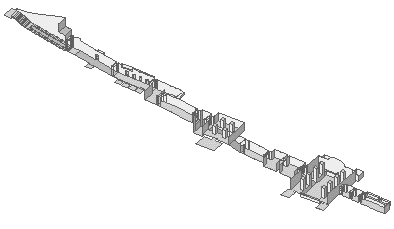![]()
Valley of the Kings - KV11
tomb of Ramesses III - XXth Dynasty
|
The tomb was begun by Setnakht, who then abandoned it and turned to KV14 where he was buried. Setnakht son, Ramesses III, resumed work on KV11 and was interred here. Although the first three corridors were constructed by Sethnakht, the niche-like side chambers in the first two passages are believed to have been added by Ramesses III. At that time, the third corridor, which had penetrated the roof of KV10 (the tomb of Amenemose), was turned into a small room from which the rest of the tomb was cut on a shifted axis. Thus the fourth corridor uniquely rises to clear the underlying chamber of KV10, and the tomb then continues its planned descent to a well room and to the pillared hall with subsidiary chamber. Another passage then leads to the anterooms and the burial chamber. The four subsidiary chambers are symmetrically placed at each corner. Ramesses III's sarcophagus had originally been intended as an outer container for Seti II. The woodentrough of Ramesses III's second-innermost coffin was discovered in the KV35 royal cache containing the mummy of Amenhotep III. The king's mummy was found among other mummies of kings in the cache DB320 in Deir el-Bahari, in once-gilded cartonage case within the massive mummy case of Queen Ahmes-Nefertari.
|
|
|
|

A - descending steps and ramp
|
![]()
|
Copyright © 2000-2013 Dariusz Sitek, Czestochowa - Chicago - Ann Arbor |